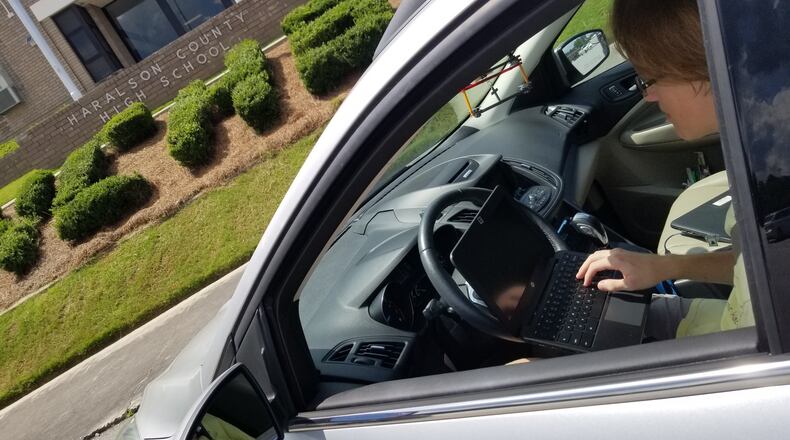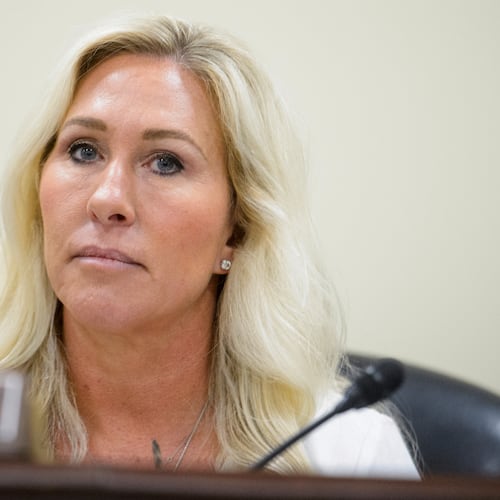The internet signal is so weak in rural west Georgia that real estate agent Renae Bell drives around to libraries, schools and McDonald’s, searching for a public Wi-Fi hotspot where she can receive final offers on homes.
Bell recently woke up for a call with her doctor at 4 a.m., the only time internet speeds were fast enough to handle video. Cars filled with students park outside her county’s local high school, which provides online access for them to do their homework.
A new map of internet gaps in Georgia shows the depth of the problems Bell faces every day.
Over 507,000 homes and businesses, 10% of the state, lack access to sufficient internet speeds, according to the map produced by the state, believed to be the most detailed of its kind in the country. The map found 255,000 homes and businesses that the federal government had incorrectly identified as being covered by high-speed internet service.
“It’s scary at this time when our livelihood is dependent on adequate internet coverage, but we don’t have access to it,” said Bell, who lives in Tallapoosa in Haralson County, where 60% of the area can’t get online. “We’re kind of stuck. I can’t work from home most of the time. I’m constantly having to chase a signal.”
Bell has said she has lost sales when home shoppers from metro Atlanta wanted to buy but backed out when they learned about sluggish internet speeds.
Credit: Mark Niesse
Credit: Mark Niesse
Georgia’s broadband mapping effort is a step toward improving internet access. Now that communities, businesses and internet providers know exactly where coverage is missing, they can make a stronger case for millions of dollars in federal government grants to help wire their areas.
The map illustrates an urban vs. rural divide, where metro areas can easily get online while less populated regions have few options. Wide swaths of South Georgia are left to depend on slow satellite service or spotty cellphone signals.
“What we can see now is the map reflects the true picture of who lacks access,” said Deana Perry, the state’s broadband director. “Those citizens can reach out in their communities, to their local service providers, and figure out how they can be connected.”
Disconnected at home
The problems caused by inadequate internet service are especially clear in rural schools.
While school systems in metro Atlanta plan to start the school year with virtual classes because of the COVID-19 health risk, that’s not possible in places such as Oglethorpe County, east of Athens, where half of the county is offline. Students there have been given the option to work remotely in the upcoming school year, but that doesn’t help those who live miles away from internet service.
“The need is huge,” Oglethorpe Superintendent Beverley Levine said. “When school went out in March, we realized we had a huge issue. We were able to put a device in every kid’s hands, but that didn’t solve our problem.”
The school system has wired a football stadium, fire departments and churches to provide internet access. But students can’t be expected to travel to those locations, log in and then sit in cars for hours for school, Levine said.
The coronavirus heightened a long-term need for internet, said Eric McDonald, the president and CEO of the Greater Haralson Chamber of Commerce, which provides public Wi-Fi. He often sees people in the chamber’s parking lot doing business from inside their cars.
“Overnight, the internet became the school bus, the commute to work, the trip to the doctor, the conversation between grandparents and their kids,” McDonald said. “We’re an hour away from a nonstop flight to anywhere in the world, and yet you can’t get on the internet.”
Internet inaccuracies
Georgia’s broadband map, released June 30, is the result of two years of work.
The General Assembly approved a bill requiring the map in 2018, based on the idea that it could help determine how to potentially fund construction of internet lines. State subsidies haven’t materialized, but the mapping project remained.
Previous maps by the Federal Communications Commission underestimated the extent of the nation’s broadband deficiencies, said Jenna Leventoff of Public Knowledge, a Washington-based group that advocates for open networks and consumer rights. The FCC maps considered an entire census block to have internet access if even one location in that community had access; Georgia mapped each home and business property in the state.
“It helps us get an accurate picture of the digital divide,” Leventoff said. “It matters because the FCC gives out money to build out broadband based on those maps.”
In addition, the FCC overstates internet speeds. An analysis of speed test results by The Atlanta Journal-Constitution last year found internet speeds were about one-fourth as fast as those reported by the FCC, averaging about 6.3 megabits per second.
The 255,000 Georgia locations without broadband that FCC maps didn’t catch will now be much more likely to receive federal funding, said Eric McRae of the Carl Vinson Institute of Government at the University of Georgia, which developed the map in coordination with the Georgia Department of Community Affairs.
“It opens up that population to having access,” McRae said. “They’re just out of having federal funding or being granted assistance for broadband because per FCC, they’re in served census blocks.”
The map can help internet companies identify areas for expansion, and local governments can partner with them to seek federal help. The federal government hands out money case by case based on grant applications from communities across the nation.
Comcast announced last month that it’s investing $9 million to bring internet services to 7,800 homes and businesses in Carroll and Haralson counties in west Georgia.
“We will use the data captured in the map to plan future investments in broadband infrastructure,” said Alex Horwitz, a spokesman for Comcast.
Other recent projects include a $4.4 million federal grant to help the Ellijay Telephone Co. bring internet to 2,100 households in Gilmer County, and a $12.5 million grant to DoveTel Communications for 2,800 households in Carroll, Heard, and Troup counties.
AT&T is also spending money to expand internet services. A company spokesman said its participation in the FCC’s Connect America Fund subsidization program brought service to 54,000 homes and businesses in rural parts of 70 Georgia counties.
Georgia’s broadband map
The Georgia Department of Community Affairs mapped every location in the state to find out where internet service was lacking. The map gathered information provided by internet service providers to determine which areas lack access to download speeds of 25 Mbps and upload speeds of 3 Mbps. The map shows 507,341 locations, 10% of the state, can’t obtain those speeds.
Counties without broadband, by percent unserved
Glascock, 100%
Warren, 100%
Baker: 99.6%
Stewart: 99.2%
Hancock: 97.8%
Fulton: 3%
DeKalb: 2.3%
Gwinnett: 0.4%
Cobb: 0.1%
Source: Georgia Broadband Map
About the Author
Keep Reading
The Latest
Featured




